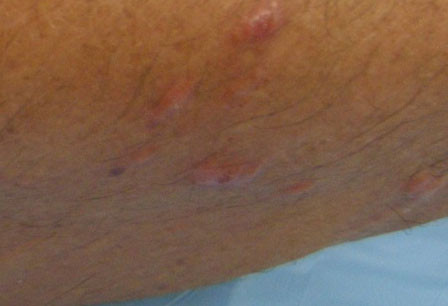Summary
Definition
History and exam
Key diagnostic factors
- pruritus
- blisters and vesicles
- weeping, oozing, and crusting
Other diagnostic factors
- previous exposure
- breathing difficulties
- generalized erythroderma
- periorbital edema
- systemic contact dermatitis
- black-spot dermatitis
Risk factors
- occupation that involves exposure to relevant trees and plants
- outdoor activities
- domestic pets and livestock
- use of forestry equipment and machinery
- smoke from burning Toxicodendron species
- children
- genetic susceptibility
Diagnostic investigations
1st investigations to order
- clinical diagnosis
Investigations to consider
- botanical identification
- black-spot test
Emerging tests
- patch test
Treatment algorithm
immediate treatment postexposure
mild dermatitis
moderate dermatitis
severe dermatitis
chronic severe dermatitis from repeated exposure
Contributors
Autores
Marius Rademaker, BM FRCP, FRACP DM, FNZDSI
Honorary Associate Professor of Dermatology
Waikato Clinical Campus
University of Auckland
Hamilton
New Zealand
Declarações
MR declares that he has no competing interests.
Revisores
Brian Swick, MD
Clinical Assistant Professor
University of Iowa College of Medicine
Iowa City
IA
Declarações
BS declares that he has no competing interests.
Christopher Lovell, MBBS
Consultant Dermatologist
Kinghorn Dermatology Unit
Royal United Hospital
Bath
UK
Declarações
CL declares that he has no competing interests.
Créditos aos pareceristas
Os tópicos do BMJ Best Practice são constantemente atualizados, seguindo os desenvolvimentos das evidências e das diretrizes. Os pareceristas aqui listados revisaram o conteúdo pelo menos uma vez durante a história do tópico.
Declarações
As afiliações e declarações dos pareceristas referem--se ao momento da revisão.
Referências
Principais artigos
Guin JD, Beaman JH, Baer H. Toxic anacardiaceae. In: Avalos J, Maibach HI, eds. Dermatologic botany. Boca Raton, FL: CRC Press; 1999.
Rozas-Muñoz E, Lepoittevin JP, Pujol RM, et al. Allergic contact dermatitis to plants: understanding the chemistry will help our diagnostic approach. Actas Dermosifiliogr. 2012 Jul-Aug;103(6):456-77.Texto completo Resumo
Guin JD, Beaman JH. Toxicodendrons of the United States. Clin Dermatol. 1986 Apr-Jun;4(2):137-48. Resumo
Paniagua CT, Bean AS. Black-spot poison ivy: a rare phenomenon. J Am Acad Nurse Pract. 2011 Jun;23(6):275-7. Resumo
Artigos de referência
Uma lista completa das fontes referenciadas neste tópico está disponível para os usuários com acesso total ao BMJ Best Practice.

Diagnósticos diferenciais
- Phytodermatitis
- Phytophotodermatitis
- Allergic contact dermatitis
Mais Diagnósticos diferenciaisDiretrizes
- Poisonous plants
Mais DiretrizesConectar-se ou assinar para acessar todo o BMJ Best Practice
O uso deste conteúdo está sujeito ao nosso aviso legal